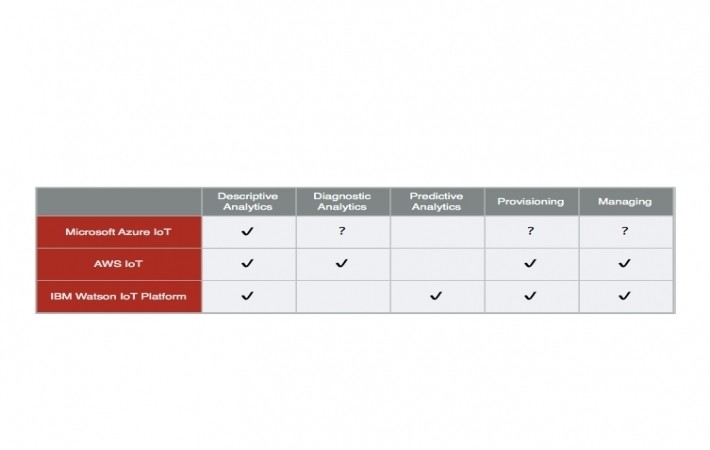
Published on 02/21/2017 | Technology
In 2016 Microsoft, IBM, and AWS each made concerted efforts to extend their IoT platforms to the edge. The main reasons for this are economics, physics and legal. Using the terminology defined in this paper; the edge is the hubs and devices in the system. In this article, we focus on the analytics capabilities that extend to the edge.
A descriptive analytics capability will identify what is happening. Descriptive analytics can be as simple as providing an alert if a value exceeds a certain value.
The IBM Watson IoT Platform provides an environment for defining rules that run in the cloud or on a hub at the edge. IBM announced the capability as part of the Cisco partnership and recently made it generally available.
The recent AWS Greengrass announcement allows for AWS Lambda behavior to run on a hub. A descriptive analytic is written in one of the languages supported by AWS Lambda.
The Azure platform mentions edge analytics here, but it does not provide any specific tools or extensions to existing analytics capabilities to run edge analytics.

Why is it happening? Diagnostic analytics can help to determine why an alert is triggered and whether it is relevant or not. Often organizations use diagnostic analytics they develop the models for predictive analytics.
None of the three platforms offers the ability to run diagnostic analytics models at the edge. With AWS Greengrass, in theory, a diagnostic model could be developed as a Lambda and run at the edge.
What will happen? The most common use case of predictive analytics is predictive maintenance. More and more use cases are attempting to predict positive outcomes. For example, analyzing parts that come off a production line to predict those parts that do not need further testing.
The three platforms provide cloud-based services to build and execute predictive models. However, none of them provides the ability to provision and run the predictive model at the edge.
ADLINK, IBM, and Intel collaborated on enabling predictive maintenance and quality models to run on a hub at the edge. For more information see,
Being able to build analytics models is fine. But, there is a need to be able to push those models to the parts of the system where it makes the most sense to execute them. For this article, we are concerned with the ability to provision the gateways or things in the system.
Provisioning of descriptive analytics to the edge can be configured and managed from the Watson IoT Platform. AWS IoT is fully capable of provisioning of Lambdas from the AWS IoT cloud to hubs or things running AWS Greengrass. For Microsoft Azure IoT, the public documentation does not reveal anything on this aspect.
The article has made no attempt to make any specific recommendations about which platform is better. Its goal is to provide the reader with information in order to help them make an informed decision for their specific use case.
Hopefully, you find it useful and please leave comments and suggestions.
This article was originally posted on LinkedIn.